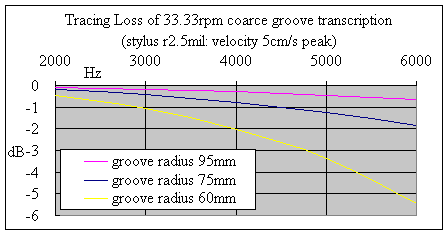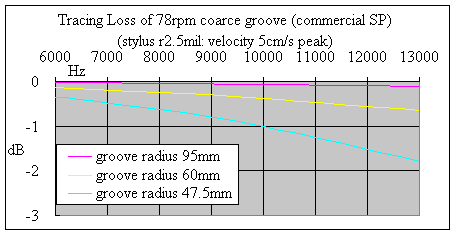About other record dimensions, please see also JIS S8502-1973 etc
| Comparative Table of Standards for 30cm LP | ||||||||
| Item of Description | Standards | IEC98-1958 | RIAA-1963 | IEC98-1964*2 | BS1928-1965 | DIN45547-1981 | IEC98-1987 | |
| Recorded Outer Diameter (Max) | 292.1mm (11.5inch) | 11 1/2" | 292.6mm (11.52inch) | 292.6mm (11.52inch) | 292.6mm | 292.6mm | ||
| Recorded Inner Diameter (Min) | 120mm (4 3/4inch)*1 | 4 3/4" | Nil | Nil | 115mm | Nil | ||
| Finishing Groove Diameter (concentric) | Nil*5 | 4 3/16" +/- 1/32" | 106.4+/-0.8mm (4 3/16+/-1/32inch) | 106.4+/-0.8mm (4 3/16+/-1/32inch) | 106.4+/-0.8mm | 106.4+/-0.8mm | ||
| Lead-out Pitch | 6.35+/-3.18mm (1/4+/-1/8inch) | 2 to 6 grooves/inch (4.2-12.7mm) | 6.4+/-3.2mm (1/4+/-1/8inch) | 6.4+/-3.2mm (1/4+/-1/8inch) | 6.4+/-3.2mm | 6.4+/-3.2mm | ||
| Lead-in Pitch | NIL | 1/32"-1/16" (0.8-1.6mm) | 0.8-1.6mm | 0.8-1.6mm with NOTE: maximum 1.2mm for LP having a raised rim | 0.8-1.0mm | 1.2mm+/-0.4mm | ||
| Eccentricity of hole to groove spiral*3 | 0.2mm(0.008inch) | runout of recording grooves relative to center hole: 0.050" max. (1.27mm) See remark *7 | 0.2mm (0.008inch) | 0.13mm (0.005in) | 0.2mm | 0.2mm | ||
| Eccentricity of hole to disk periphery*3 | 0.8mm (1/32inch) | 0.8mm (1/32inch) | 0.4mm (1/64inch) | Nil | Nil | |||
| Unbalance (allowable off-centre gravity) | Nil | Nil | Nil | 11.1mm(7/16inch)*4 | 8mm | 8mm | ||
| Diameter of Centre Hole | 7.24 -0/+0.09mm (0.285-0.2885inch) | 0.286" +0.001" -0.002" | 7.24 -0/+0.09mm | 7.24 -0/+0.09mm (0.285-0.2885inch) | 7.24 -0/+0.09mm | 7.24 -0/+0.09mm | ||
| VTA (Vertical Tracking Angle) | Nil | 15 degrees | about 15 degrees | 15 to 25 degrees*4 | 20+5/-0 degrees (VMA)*5 | 20+5/-0 degrees | ||
| Stylus Tip Radius (Spherical) | Monophonic: 0.020 to 0.026mm(0.8 to 1mil) | Stereophonic: desirable 0.5mil (0.013mm) | Stereophonic: 0.013 to 0.018mm(0.5 to 0.7mil) | with NOTE: "For both monophonic and stereophonic application, the preferred range of tip radius should be: 0.015 to 0.018mm (0.6 to 0.7mil)"*4 | Nil | Nil | ||
| Monophonic: 0.013 to 0.025mm(0.5 to 1mil) | ||||||||
| Included angle of spherical tip | 40 to 50 degrees | Nil | 40 to 55 degrees | 40 to 55 degrees | Nil | less than 55 degrees | ||
| Groove Angle | 88+/-5degrees | 90/+ 5 degrees | 90degrees | 90+/-5degrees | 90+/-0.7degrees | 90+/-5degrees | ||
| Bottom Radius (Maximum) | 7.5micron (0.0003") | (6.35micron) 0.00025" | 4micron (0.00015") | 4micron/(8micron)*4 | 8micron | 8micron | ||
| Top Width of Groove (Monophonic) | >55micron(0.00215") | 0.0022"-0.0032" | >51micron (0.002") | >51micron (0.002") | *6 | Actual dimension: minimum 30micron (see my remark *6) | ||
| Top Width of Groove (Stereophonic) | Nil | Instantaneous 0.001" min | Nil | Nil (preferably not less than 25micron and average not less than 35micron)*4 | Average more than 35micron Instantaneous more than 25micron | |||
| Figures in inch unit precede those in mm for IEC98-1958 & BS1928-1965. | ||||||||
|
Remarks: |
*1 | In the first edition of IEC98 (Section F5 Page 21) the "minimum diameter of recorded surface" is quoted for transcription recordings (Section F for broadcasting use) only. There is no corresponding description about minimum diameter for commercial disk records (Section E). See Contents of IEC 98 (1958) | ||||||
| *2 | I picked up the figures for IEC98-1964 from BS1928 as BS1928-1965 was based on 2nd edition of IEC(1964). Mirror documents with respective notes when BS differs from IEC descriptions. BS1928:1965 was replaced by BS7063:1989(=IEC98:1987) | |||||||
| *3 | The permissible eccentricity of the centre hole relative to the groove spiral and to the disk periphery shall be as follows: | |||||||
| Eccentricity to groove spiral: | The eccentricity of the centre of the centre hole to the centre of the groove spiral. | |||||||
| Eccentricity to disk periphery: | The eccentricity of the centre of the centre hole to the centre of the disk periphery. | |||||||
| RIAA (Bulletin E4) commented on Runout of Recording Grooves Relative to Center Hole as follows: "This figure does not imply that a record having this degree of run-out would be acceptable from a quality standpoint. It does provide, for instance, a limit for the maximum sensitivity or a velocity trip when combined with the pitch of spirals between individual bands." | ||||||||
A B B C C We
find various types of eccentricity in hole and groove. We
find various types of eccentricity in hole and groove.
Moyer of RCA invented USP3,000,005(1961): Off-Center Indicator to check the concentricity of phonograph records and metal phonograph stampers, and said: "In producing a metal stamper, the center hole is obliterated during the plating process. It is necessary to punch a center hole in each metal stamper. If the punched hole is not substantially concentric with the recording spiral on the stamper, within permissible tolerances, the records produced from the stamper will exhibit the objectionable characteristics of wow." |
||||||||
| *4 | As per Amendment Slip No. 1 published 26 January 1972 to BS1928-1965 | |||||||
| *5 | IEC98(1958):
Diameter
of concentric finishing groove 98.4mm was quoted for 45 rpm record.
Corresponding finishing groove radius for 33.3rpm record was under
consideration at the time. 106.4+/-0.8mm was quoted in DIN 45537(Monaural
Records 33.3rpm) & DIN 45547(Stereo Records 33.3rpm) both Nov. 1962.
DIN 45547 seems to define VMA (vertical modulated angle) for the nature of stereophonic groove. |
|||||||
| *6 | DIN 45537 in 1962 (Monaural Records 33.3rpm) indicated top width: more than 55micron while bottom radius less than 4micron. By the way it is uncertain whether monophonic groove dimensions in stereo age/cutter were differing from monophonic groove dimensions in original monaural age/cutter or not. It may depend on the density of pitch (for example: original two sides recordings can be compressed to one side by the development of cutting engineering) or the cutting engineer's idea at the time. Since 1970 it was believed that the minimum top width of monophonic groove could be reduced to 30microns as indicated in IEC98-1987 though this standard has not clarified its application to monophonic groove. I think Amendment Slip No. 1 published 26 January 1972 to BS1928-1965 (where the tip radius 0.6-0.7mil can be commonly recommended for both monophonic and stereophonic application) is corresponding to this change of minimum top width for monophonic groove. | |||||||
| *7 | RIAA Bulletin No. E4 made following Note : This figure does not imply that a record having this degree of run-out would be acceptable from a quality standpoint. It does provide, for instance, a limit for the maximum sensitivity or a velocity trip when combined with the pitch of spirals between individual bands. | |||||||
Centre hole diameter for both LP and SP was stipulated around 7.24mm(IEC) or
7.26mm(RIAA), but we find odd records which are beyond standards: not true round
hole or burr around hole or bigger hole etc. Spindle diameter for LP as per
NAB[1964] clause 1.40 was 0.2830+0.000/-0.0005inch (7.188-7.176mm), but I find various sizes
of spindle diameter from 7.13 to 7.2mm according to turntables. I think that
spindle diameter 7.2mm is too thick to receive various records without problem.
IEC allowed 0.2mm eccentricity for record proper, but in our playing records
actually the eccentricity often exceeds more than 0.5mm (=1mm as arm swinger) so that I can hear wow
at the end of music sometimes.
Some professional turntables have rather thinner
spindle diameters since prompt change of records is their purpose:
Specification sheet for EMT920=R80 in 1952 indicated spindle diameter
6.95±0.05mm in order to play various records including SP records. Technics
professional turntable FR-956A around 1979 specified spindle diameter
7.126+/-0.01mm - it is common in other Technics turntables in same era as far
as I know. It seems that
spindle diameter is not standardised as any international standard. Record
stabilisers/clamps/weights have hole diameters around 7.3mm usually to fit in
most turntable spindles.
Definition from IEC-98(1958):
C1. Commercial disk records (gramophone records, phonograph records). Processed recordings, usually pressings, made by usual commercial process and normally on sale to the public.
C2. Transcription recordings. Recordings made for programme interchange between broadcasting organizations and for other specialized purpose, not normally on sale to the public. Transcription recordings may be either "Direct Recordings" or "Pressings".
C3. Direct recordings. Recording made on disks (e.g. lacquer coated disks) which are suitable for direct reproduction without processing.
C4. Pressings. Copies of direct recordings obtained by a pressing operation similar to that used in normal commercial disk record manufacture.
C5. Commercial disk record playing unit. An assembly of a commercial disk record motor, turntable and pick-up on a common mounting plate.
C6. Commercial disk record changer. A commercial disk record playing unit with the addition of mechanism to enable series of records to be automatically played in sequence.
C7. Transcription turntable assembly. A reproducing turntable and its driving mechanism specially adapted for the reproduction of transcription recordings.
Sizes of Transcription Records as specified in IEC98(1958):
| 3 3/4in (95mm) | Minimum diameter of recorded surface for 78rpm coarse groove |
| 7 1/2in (190mm) | Minimum diameter of recorded surface for 33 1/3rpm coarse groove |
| 4 3/4in (120mm) | Minimum diameter of recorded surface for 33 1/3rpm fine groove |
| 9 1/2in (241.3mm) | Outer diameter of recorded surface for 10inch (250mm) Direct recordings |
| 11 1/2in (292.1mm) | Outer diameter of recorded surface for 12inch (300mm) Direct recordings |
| 11 1/2in (292.1mm) | Outer diameter of recorded surface for 12inch (300mm) Pressings |
| 11 1/2in (292.1mm) | Outer diameter of recorded surface for 13inch (330mm) Pressings |
| 15 1/2in (393.7mm) | Outer diameter of recorded surface for 16inch (400mm) Direct recordings |
| 15 1/2in (393.7mm) | Outer diameter of recorded surface for 17inch (430mm) Pressings |
| The recorded surface shall mean the modulated groove (not the plain/non-modulated groove) | |
There is a clause F3 mentioning as follows :The disk diameters of transcription recordings are under consideration. For pressings of direct recording disk the dimensions of Clause E3 (commercial disk diameters) apply.
| Nominal diameter |
Actual disk diameter | Notes |
| 12 inch (300 mm) | 11 7/8+/-1/32 in (301.6+/-0.8mm) | Most European disks lie within 11.8+/-0.1 in (300+/-2.5mm) |
| 10 inch (250mm) | 9 7/8+/-1/32 in (250.8+/-0.8mm) | Most European disks lie within 9.85+/-0.08 in (250+/-2mm) |
| 7 inch (175 mm) | 6 7/8+/-1/32 in (174.6+/-0.8mm) |
7 1/2in (190mm) as minimum diameter of recorded surface for 33 1/3rpm coarse groove transcription is double of minimum diameter for 78rpm coarse groove. I think this minimum diameter was decided in consideration of tracing loss of high frequency at reproduction. For example I simulated as under: stylus tip spherical radius 2.5mil(63.5micron) and recorded velocity 5cm/s peak lateral (constant velocity from 1kHz up). This loss in case of hill-and-dale modulation becomes greater than lateral so that IEC98-1958 does not refer to hill-and-dale transcription record any more. Conclusion: 33 1/3rpm coarse groove transcription had no merit after 33 1/3rpm fine groove was realised.

